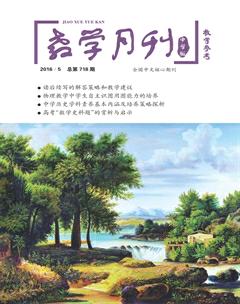读后续写的解答策略和教学建议
骆敏洁+周道义
摘 要:读后续写题型结合阅读理解进行写作,将语言输入与输出紧密结合,将语言的模仿与创造性使用有机结合,将语言的学习与运用切实结合,旨在考查学生的综合语言运用能力。答题时,考生要把握短文核心内容,理清写作思路,使续写内容与原文之间逻辑衔接、情节和结构完整。教师在进行读后续写的教学中,形式要多样,方法要灵活,选文要适合,评价要促学,从而提高学生的读写能力,使理解与产出紧密结合起来。
关键词:读后续写;解答策略;教学建议
浙江作为高考综合改革试验省份,将于2016年10月启动英语学科一年两考的第一次高考。新高考将出现新的写作题型——读后续写。这一题型一经公布,立即引起了社会的极大关注。对于这样一个全新的写作题,考生在考试时该如何解答呢?教师又该如何开展相应的教学呢?我们先来认识一下读后续写这一题型。
一、题型解读
读后续写是一种将阅读与写作紧密结合的考查方式,旨在考查学生的综合语言运用能力[1]。读后续写题型结合阅读理解进行写作练习,将语言输入与输出紧密结合,将语言的模仿与创造性使用有机结合,将语言的学习与运用切实结合,是提高外语学习效率的好方法[2]。
(一)题型叙述
提供一段350词之内的语言材料,要求考生依据该材料内容、所给段落开头语和所标示关键词进行续写(150词左右),将其发展成一篇与给定材料有逻辑衔接、情节和结构完整的短文[3]6。
(二)阅卷角度
1.与所给短文及段落开头语的衔接程度;2.内容的丰富性和对所给关键词语的覆盖情况;3.应用语法结构和词汇的丰富性和准确性;4.上下文的连贯性[3] 6-7。
(三)考查内容
以阅读理解为基础,以写作为产出。阅读是输入、是基础,写作是输出、是提升。读后续写题考查语言知识(词汇、语法等)、阅读能力(阅读技巧、理解能力、文本分析等)、逻辑思维能力和写作能力。
(四)选文体裁特色
以记叙文为主,一般不会出现说明文或议论文。因为记叙文话题更贴近生活,上下文连贯性强,结构清晰,在结尾处常有结局(结论)或提升,更适合用于读后续写题型。
(五)选文题材特色
故事性强,主题有一定的背景,材料有趣味性,内容能延伸,能激发学生的想象力和续写冲动。阅读材料难度适当,易于理解和模仿。
(六)题型特点
试题兼顾引导和限制。10个画线词汇(续写中必须选用5个以上)、段落要求以及每段的开头语,既能引导考生顺势构思,又能防止考生偏离主题无限想象,便于准确评分。
二、答题策略
下面,举一具体实例,来谈谈如何进行读后续写的写作。
(一)题目
阅读下面短文,根据所给情节进行续写,使之构成一个完整的故事。
Right beside You
It had been a year since Susan, thirty-four, became blind. As the result of a medical accident she was sightless, suddenly thrown into a world of darkness, anger, frustration and self-pity. Once an independent woman, Susan now became a powerless, helpless burden on everyone around her. No matter how much she cried or prayed, she knew the painful truth that her sight was never going to return. All she had to cling to was her husband Mark.
Mark was an Air Force officer and he loved Susan with all his heart. When she first lost her sight, he watched her sink into despair and he became determined to use every means possible to help his wife.
Finally, Susan felt ready to return to her job, but how would she get there? She used to take the bus, but she was now too frightened to get around the city by herself. Mark volunteered to ride the bus with Susan each morning and evening until she got the hang of it. And that is exactly what happened.
For two weeks, Mark, military uniform and all, accompanied Susan to and from work each day. He taught her how to rely on her other senses, specifically her hearing, to determine where she was and how to adapt to her new environment. He helped her befriend the bus drivers who could watch out for her, and save her a seat.
Each morning they made the journey together, and Mark would take a taxi back to his office. Although that meant he had to travel through the city and the routine was costly and exhausting, Mark knew it was only a matter of time before Susan would be able to ride the bus on her own. He believed in her.
Finally, Susan decided that she was ready to try the trip on her own. Monday morning arrived. Before she left, she embraced her husband tightly, her eyes filled with tears of gratitude for his loyalty, his patience, and his love. She felt she was so lucky for he had given her a gift more powerful than sight.
注意:
1. 所续写短文的词数应为150左右;
2. 应使用5个以上短文中标有下划线的关键词语;
3. 续写部分分为两段,每段的开头语已为你写好;
4. 续写完成后,请用下划线标出你所使用的关键词语。
Paragraph 1:
She said goodbye and, for the first time, they went their separate ways.
Paragraph 2:
On Friday morning, as Susan was stepping onto the bus as usual, the driver said,“Miss, I sure envy you.” Curious, Susan asked the driver why.
(二)答题步骤
1.把握短文核心内容
仔细阅读所给短文,把握短文核心内容是完成续写的前提。“Right beside You”一文的核心内容为:Susan由于一次医疗事故而导致双目失明。处于极度悲伤的Susan得到了丈夫Mark真挚而深沉的爱和体贴的帮助。在Mark无微不至的关爱、鼓励和照顾下,Susan重拾自信,积极面对新的生活,同时也让我们理解了爱的真谛。
2.理清写作思路
(1)明确故事人物关系
故事中的主要人物为Susan, Mark, the bus driver。Susan和Mark是一对夫妻,the bus driver是Susan上下班途中的公交司机。
(2)理清故事主要事件
Susan因为一次医疗事故而导致双目失明;Susan极度悲伤,对生活失去了信心;Mark对Susan不离不弃,帮助Susan重拾信心;Susan在Mark的帮助下,能够独立面对新的生活。
(3)预测故事发展
根据已知人物、事件及要求续写段落的首句可以预测故事总体的发展应该是Susan在Mark的帮助下,重拾信心,能够独立地面对新生活。
根据要求续写段落Paragraph 1提供的开头语“She said goodbye and, for the first time, they went their separate ways”可以预测,下文可能是描写Susan第一次独自乘公交车的具体情景。这一情景将通过动作描写来展现一位盲人在公共场合的行为。这样的预测内容紧跟文本,合乎逻辑。从Paragraph 2提供的开头语“On Friday morning, as Susan was stepping onto the bus as usual, the driver said,‘Miss, I sure envy you.Curious, Susan asked the driver why”可以预测,接下来就是司机解释了为什么羡慕Susan的原因。这原因可能是对前面Mark所做事情的一个总结,也可能是进一步拓展,Mark为Susan做的一些其他令人感动的事情。
(4)罗列写作要点
结合选文中画线词语和文本内容,展开尽可能丰富的想象,罗列出尽可能多的故事发展情节。例如,第一段可以通过问以下问题来获取写作要点。
Question 1: Could Susan go to work on her own?
Points: She had some difficulty; She made her way carefully up the steps with the white cane; She got on the bus carefully and slowly ...
Question 2: How did she make her way?
Points: She paid the driver; She felt her way to the seat; She put down her briefcase and placed her cane against her leg ...
第二段可以通过问以下问题来获取写作要点。
Question 3: Why did the driver envy Susan?
Points: Her husband watched and accompanied her every time she went to work; He watched her cross the street and go into her office building ...
Question 4: How did Susan feel after she got the answer?
Points: She was excited and deeply moved to tears when she got the truth; She was full of gratitude and happiness ...
3.完成续写任务
She said goodbye and, for the first time, they went their separate ways. She made her way carefully up the steps with the white cane. She paid the driver and then, using her hands to feel the location of the seats, settled into one. She placed her briefcase on her lap and rested her cane against her leg. Monday, Tuesday, Wednesday, Thursday ..., each day everything on her own went perfectly. She was doing it!
On Friday morning, as Susan was stepping onto the bus as usual, the driver said,“Miss, I sure envy you.” Curious, Susan asked the driver why.“You know, every morning for the past week, a fine looking gentleman in a military uniform has been standing across the corner watching you when you get off the bus. He makes sure you cross the street safely and he watches you until you enter your office building. You are one lucky lady,” the bus driver said. When she knew the fact, tears poured down Susans cheeks, tears full of gratitude and happiness as well. Susan knew that she wouldnt have made such great progress without Marks help. Its Marks love that brought light into darkness.
三、答题技巧
(一)合理拓展情节
读后续写首先要读通给定文本,把握故事的人物和事件。在此基础上根据提示对故事的发展做出合情合理又合乎逻辑的预测。为了将预测过程显性化,可以通过设问的方式,将预测重点以问题的方式显示出来,有利于后续写作时的信息整理和语言组织。在以上例子中,我们通过四个问题来拓展整理自己的写作思路。这四个问题以事情发展的进程以及Susan的变化为中心,问题之间有一定的逻辑联系,符合故事发展的合理结局。
(二)有效运用连接手段
在具体的写作过程中我们要对罗列的要点进行筛选和整合,还要考虑写作要点之间连接手段的有效运用,例如范文中for the first time, each day等词的运用体现时间上的逻辑关系。这些连接词的使用可以使文本更加紧凑连贯。
四、教学建议
读后续写需要学习者先理解原文,构建情境模式,而后创造性地续写内容。在创作过程中,学习者需与原文的情境模式协同,以确保续写的内容和语言与原文连贯。
语言理解的主要方式有听和读,语言产出的主要形式有说和写。从听说读写四种基本语言技能来看,理解和产出有四种组合,分别是:听说结合、听写结合、读说结合、读写结合。这些结合都能促进语言学习,但是它们的区别是理解与产出结合的强度不同。两者结合越紧密,交互协同越强劲,拉平效应越显著,学习效率越高。以理解与产出紧密结合的标准来衡量,读后续写不仅将理解与产出紧密结合起来,而且符合外语语境下听说机会较少而读写条件充分的特点,是一种提高外语学习效率的好方法。基于以上认识,我们提出以下教学建议。
(一)形式要多样
读后续写的教学形式除了读写结合外,还可以用听说结合、听写结合、读说结合等。比如,听说结合可以是先听后复述,或听后说出每一段的段落大意;听写结合有各种听写方式,包括听后写出文本的主题大意;读说结合有读后口头复述课文,或读后进行小组讨论以把握故事发展线索。
(二)方法要灵活
为了帮助学生理清思路,教学时可以保留被抹去段落的主题句或者段落首句;或者提供开头或结尾,要求续写中间部分;或者画出阅读材料中有助于续写的短语、句型或关键词,提醒学生运用;或者让学生分小组讨论阅读材料的续写内容,加强互动,激活想象力,合作完成续写任务。
(三)选文要适合
阅读材料的语言难度要控制,要易于模仿。生词太多、语言太难会影响理解,不利于续写。阅读材料不宜太短。阅读材料是模仿的样板,材料适当长一些,内容就丰富一些,语言变化也多些,这样续写思路更加明确,协同更易发生,内容更加连贯。多向学生推荐阅读材料,进行不加限制的续写,启发思维,提高阅读写作能力,巩固语言知识。如推荐O Henry的短篇小说“The Cop and the Anthem”“The Gift of the Magi”“The Last Leaf”“A Cosmopolite in a Cafe”以及Mark Twain的“Running for Governor”等等。
(四)评价要促学
批改和评分要以促学为导向。评分标准要包括内容和语言两个方面:续写的内容要求思维清晰,想象丰富,与阅读材料的内容连贯;语言表达要求准确流畅,使用阅读材料中的词语和句型较多且恰当。
参考文献:
[1]刘庆思,陈康.关于一年两考高考英语试卷中读后续写设计的研究[J]. 中小学外语教学(中学篇),2016(1):2.
[2]王初明.读后续写——提高外语学习效率的一种有效方法[J].外语界,2012(5):2.
[3]中华人民共和国教育部考试中心.普通高等学校招生全国统一考试英语科考试说明(高考综合改革试验省份试用)(第一版)[M]. 北京:高等教育出版社,2015.

